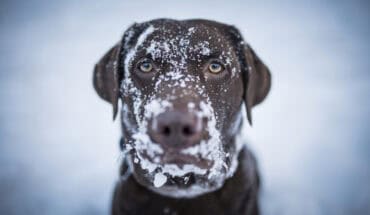Dog burns and scalds: How to help if your dog suffers a painful burn or scald:
Safety first
If your dog suffers a painful burn or scald, it is vital to ensure your own safety and keep everyone safe from further danger.
Avoid getting burnt yourself – turn off power, extinguish flames. Additionally, to prevent your pet biting you, it may be necessary to muzzle them. Unfortunately, if your dog is in pain and stressed they may snap and hurt you.
Treat a dog burn with cool running water
For minor burns cool the burn as quickly as possible using cool running water. Ideally cool the burn for a full 20 minutes. Position the running water to enable it to drain from the nearest exit point to prevent running cool water unnecessarily over your pet.
You are trying to cool the burn, without over-cooling your dog.
Call the vet
Further treatment and advice:
- Keep your pet warm and do your best to avoid them going into shock.
- Avoid touching the burn and wear sterile gloves if at all possible.
- Do not apply any burns or creams.
- Never apply ice to a burn.
- You should never burst blisters.
This advice relates to first aid for minor burns on animals; for more serious burns where the skin has become visibly blistered or damaged, you should get veterinary advice immediately and do as instructed by them.
Size, cause, age, location and depth all affect how severely your pet is burned
Size
The larger the area involved, the more serious it is for your pet and the more likely they are to suffer from shock, due to the loss of fluid from the burn. Pain, stress and being cold will make shock worse, so it is important to try and remain calm and keep the rest of your pet warm, whilst cooling the burn. Get veterinary advice quickly.
Cause
A burn can be caused by many different things.
Scalds are common injuries to pets caused by spills from hot liquids, such as kettles, saucepans full of hot water, steam and hot drinks.
In a house fire the flames will burn the fur and skin, but animals can also gain burns to their airways from the heat contained in the air which, when breathed in, damages the delicate linings within the lungs. Smoke inhalation is also a concern and if they have been involved in a house fire your pet must always be checked by a vet to prevent serious breathing problems.
Electrical injuries occur most commonly in the home if your pet chews an electrical flex. Always turn off the mains electricity before touching your pet as otherwise you will be electrocuted too.
Chemical burns are most commonly caused by household cleaners and garden chemicals. De-icing products and rock salt in winter can also burn a dog’s paws.
Age
Burns are more serious in puppies than in older dogs
Location
Burns to the; paws, face, genitals, airways, or a burn that extends all the way around a limb, are particularly serious. Keep the burnt area under cool running water and contact the nearest vet immediately.
Depth
Superficial, partial thickness or full thickness burns: The advice for first aid treatment for animal burns relates to superficial burns. For more serious burns where the skin is visibly damaged, call the vet and adhere to their advice.
A dog burn is serious
Often dogs have different depths of burn within a single injury. Determine the depth of the burn:
Superficial burn has just affected the top layer of skin. It is really painful and likely to blister.
Partial thickness burn is really painful. The burn has gone through both the first and second layer of skin
Full thickness burns are often not as painful as the nerves have been very severely damaged too. This is the most severe sort of burn, the skin may appear pale, white or charred it will require extensive treatment and skin grafts.
- What is a seizure? - 13th March 2025
- Febrile Convulsions and Seizures in Children - 13th March 2025
- Why women are less likely to receive CPR or survive cardiac arrest - 6th March 2025







